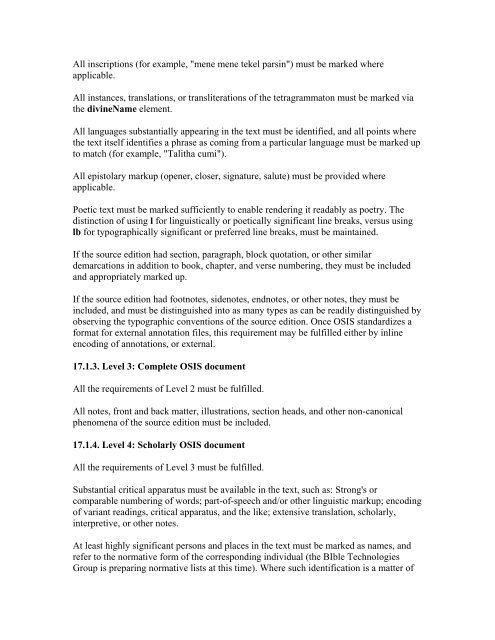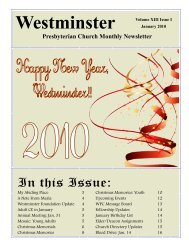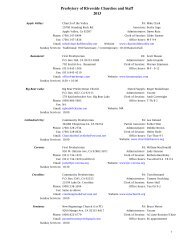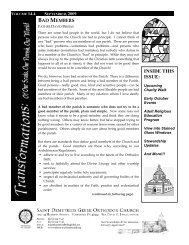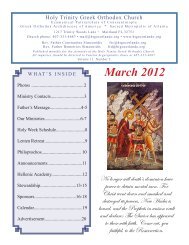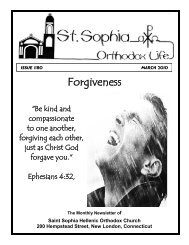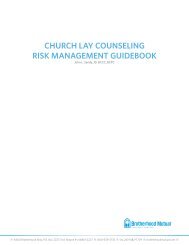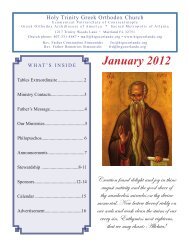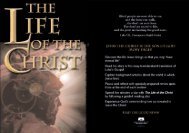OSIS? 2.0.1 User's Manual - Web services are running on AMBIB
OSIS? 2.0.1 User's Manual - Web services are running on AMBIB
OSIS? 2.0.1 User's Manual - Web services are running on AMBIB
You also want an ePaper? Increase the reach of your titles
YUMPU automatically turns print PDFs into web optimized ePapers that Google loves.
All inscripti<strong>on</strong>s (for example, "mene mene tekel parsin") must be marked where<br />
applicable.<br />
All instances, translati<strong>on</strong>s, or transliterati<strong>on</strong>s of the tetragrammat<strong>on</strong> must be marked via<br />
the divineName element.<br />
All languages substantially appearing in the text must be identified, and all points where<br />
the text itself identifies a phrase as coming from a particular language must be marked up<br />
to match (for example, "Talitha cumi").<br />
All epistolary markup (opener, closer, signature, salute) must be provided where<br />
applicable.<br />
Poetic text must be marked sufficiently to enable rendering it readably as poetry. The<br />
distincti<strong>on</strong> of using l for linguistically or poetically significant line breaks, versus using<br />
lb for typographically significant or preferred line breaks, must be maintained.<br />
If the source editi<strong>on</strong> had secti<strong>on</strong>, paragraph, block quotati<strong>on</strong>, or other similar<br />
demarcati<strong>on</strong>s in additi<strong>on</strong> to book, chapter, and verse numbering, they must be included<br />
and appropriately marked up.<br />
If the source editi<strong>on</strong> had footnotes, sidenotes, endnotes, or other notes, they must be<br />
included, and must be distinguished into as many types as can be readily distinguished by<br />
observing the typographic c<strong>on</strong>venti<strong>on</strong>s of the source editi<strong>on</strong>. Once <str<strong>on</strong>g>OSIS</str<strong>on</strong>g> standardizes a<br />
format for external annotati<strong>on</strong> files, this requirement may be fulfilled either by inline<br />
encoding of annotati<strong>on</strong>s, or external.<br />
17.1.3. Level 3: Complete <str<strong>on</strong>g>OSIS</str<strong>on</strong>g> document<br />
All the requirements of Level 2 must be fulfilled.<br />
All notes, fr<strong>on</strong>t and back matter, illustrati<strong>on</strong>s, secti<strong>on</strong> heads, and other n<strong>on</strong>-can<strong>on</strong>ical<br />
phenomena of the source editi<strong>on</strong> must be included.<br />
17.1.4. Level 4: Scholarly <str<strong>on</strong>g>OSIS</str<strong>on</strong>g> document<br />
All the requirements of Level 3 must be fulfilled.<br />
Substantial critical apparatus must be available in the text, such as: Str<strong>on</strong>g's or<br />
comparable numbering of words; part-of-speech and/or other linguistic markup; encoding<br />
of variant readings, critical apparatus, and the like; extensive translati<strong>on</strong>, scholarly,<br />
interpretive, or other notes.<br />
At least highly significant pers<strong>on</strong>s and places in the text must be marked as names, and<br />
refer to the normative form of the corresp<strong>on</strong>ding individual (the BIble Technologies<br />
Group is preparing normative lists at this time). Where such identificati<strong>on</strong> is a matter of


